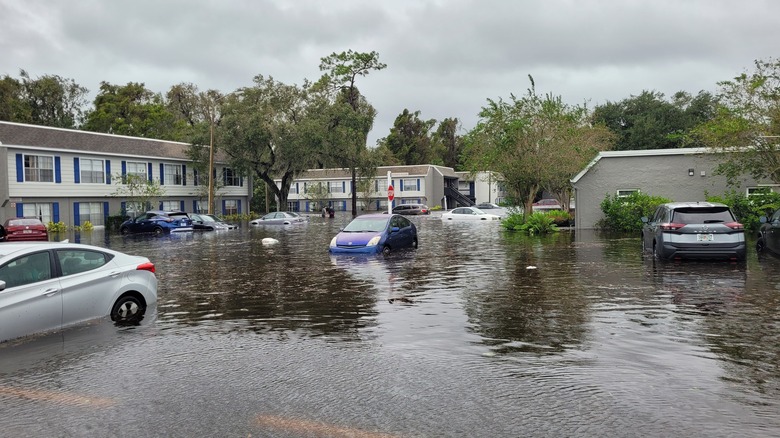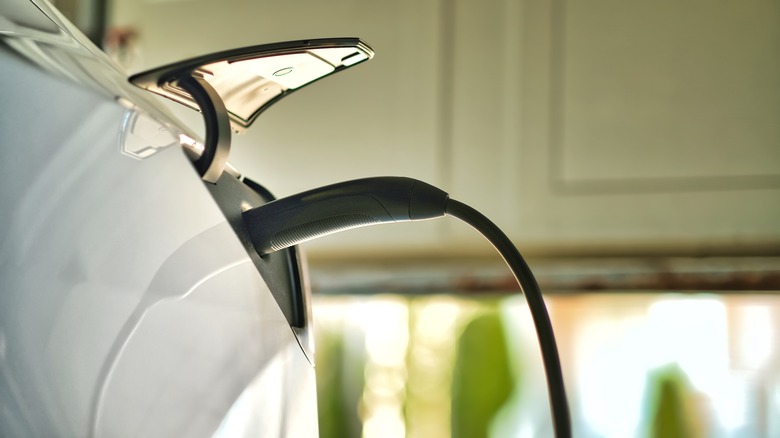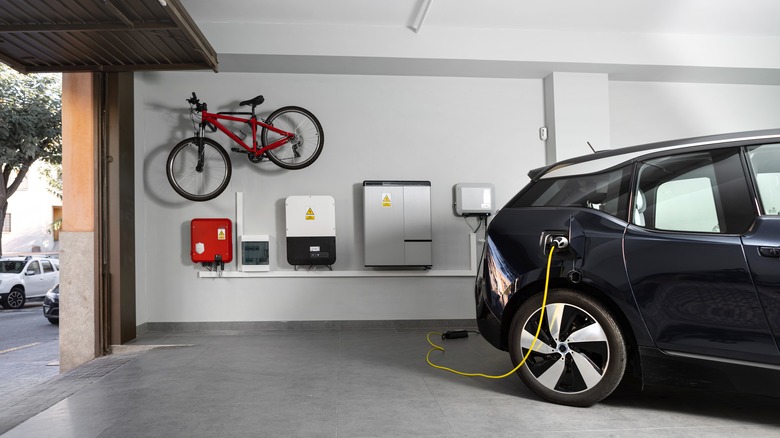Why Disaster Preppers May Want To Wait For This Electric Car Feature
So far, there have been at least 21 named storms detected over the Atlantic Ocean, the Caribbean Sea, and the Gulf of Mexico in 2022 (via CNN). Four of those graduated into hurricanes, and the weather forecasters predict there could be more on the way. The latest hurricane to make landfall in the U.S. was "Ian," which left a destructive path along the Southern Coast. Scientists also warn that wildfires could get worse in the future.
More often than not, natural disasters like tropical storms, hurricanes, or wildfires cause power outages that can go on for days. Backup generators, flashlights, portable batteries and emergency lamps help to survive a power outage. Solar panels and a Tesla Powerwall or any lithium reserve batteries can also help make a big difference during a grid outage — but they can be impractical if you're living in a rental. However, you could consider another alternative to power your home if the grid goes offline in case of a natural disaster — but you need an electric vehicle with that feature.
Bidirectional charging can be a lifesaver
A few electric vehicles nowadays are designed with bidirectional charging capability. This means that you can charge your electric vehicle, and during a power outage, your electric vehicle can return the favor by lighting up your home. It works almost like a Tesla Powerwall, but instead, you're using the electric car's battery as a backup. In fact, backing up power from your electric vehicle's battery could be cheaper and more convenient, considering a single Tesla Powerwall 13 kWh battery will cost over $20,000 to install. On the other hand, the cheapest electric car, the Chevrolet Bolt with a price tag of $25,600 comes with a 65-kWh lithium-ion battery.
To put it into perspective, a fully charged Chevrolet Bolt with a 65-kWh battery would have enough juice to back up your home for three days during a storm outage — assuming you consume 20 kWh per day. In contrast, a single Tesla Powerwall 13 kWh battery can cover you for 24 hours if you live in a two-bedroom house. Even other lithium battery backup alternatives such as Kohler and Sonnen can't match the battery capacity of most electric vehicles — unless you've added multiple units, which could be expensive. However, disaster preppers may want to wait before they turning their electric cars into backup generators.
Not all electric vehicles support bidirectional charging
Unfortunately, not all electric vehicles support bidirectional charging. According to TechCrunch, bidirectional charging technology is still in the "early stages," and only a handful of EV models like the Ford F-150 Lightning, Nissan Leaf, Kia Soul EV, and Mitsubishi Outlander PHEV support it. Other automakers such as General Motors, Honda, Volkswagen, Lucid Motors, and Chevrolet have pledged to support bidirectional charging in the future.
In addition, two companies, Wallbox North America and Emporia Energy, will sell aftermarket bidirectional chargers by 2023. Even so, it remains to be seen whether aftermarket bidirectional chargers will be compatible with all EV models considering that an EV like Ford F-150 Lightning can only power your home using its own special charger. Beyond that, not every vehicle with bidirectional charging can supply electricity to your home during a power outage. An electric vehicle with V2V (vehicle-to-vehicle) bidirectional charger capability is limited to charging other electric vehicles only. Similarly, an electric car like the Hyundai Ioniq 5 with V2L (vehicle to load) feature can only charge electronics such as laptops and electric scooters or power other small appliances directly.
The V2H (vehicle to home) and V2G (vehicle to grid) models are where things get more interesting — the V2H bidirectional chargers can connect to your home in reverse, and the V2G chargers can disperse electricity back to the grid so you could share with your neighbors in case of a power outage. An example of an electric vehicle with V2G bidirectional charging technology is the Nissan Leaf (via Cars).
The Ford F-150 Lightning is the best option ... for now
If you're a disaster prepper and you can't wait until EV-to-home bidirectional charging becomes popular, the Ford F-150 Lightning is your best option. The F-150 Lightning comes with an up to 131 kWh lithium battery that would be sufficient to power your home for up to 10 days when fully charged — if you're frugal. All Ford 150 Lightning extended battery trims have V2H bidirectional charging capability. As for the installation, you are required to purchase Ford's Home Integration System and hire an electrician to rewire or upgrade your home's electrical panel. You could spend up to $5,000, but if you take advantage of the tax incentive, you could reduce your cost by $1,000.
Besides the Ford F-150 Lightning, there are currently no other EV models that offer reliable bidirectional home power backup options. The Nissan Leaf comes close, but it's limited to fleet and business buildings. However, if you can wait, other EV models that could compete with Ford F-150 Lightning charging could be available by 2023 — and over the next few years, it could be a standard feature in most EVs.



